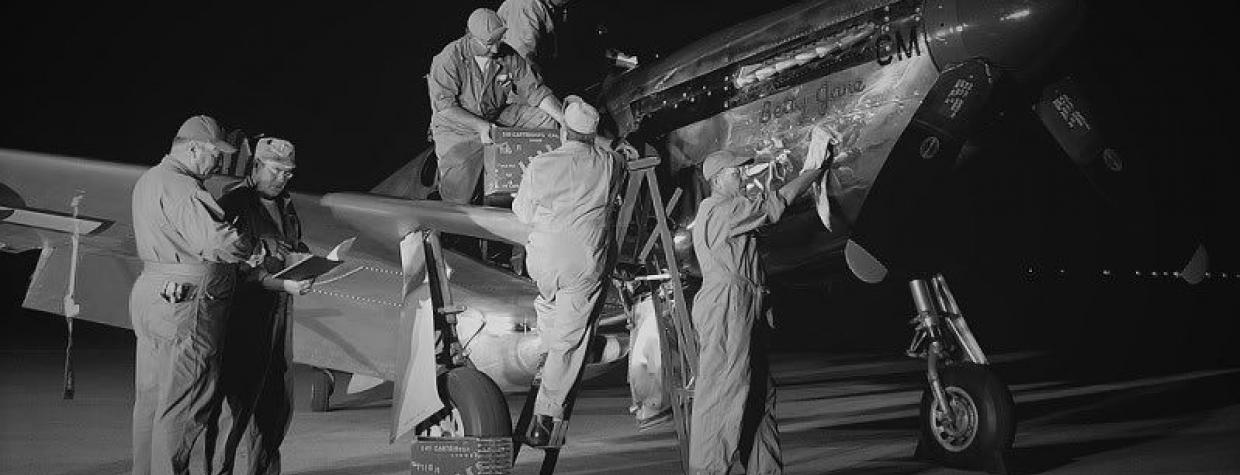Scott Dunkirk knows his history. Along with two other "living historians," Bill Gaston and Timothy Murphy, he formed the Arizona Ground Crew Living History Unit Inc. in 2006. The goal of the group, which now has 12 members, is to educate the public on the roles and importance of ground crews before and during World War II. The unit is based in Arizona but travels to surrounding states for events, including a bomber fantasy camp in Stockton, California. Dunkirk provided us with some more information about the group.
Tell us about the Arizona Ground Crew.
We’re a living-history organization, sort of a traveling museum. We portray the aircraft mechanics, electricians, the engine guys, the propeller guys and the radio guys that were on the ground, basically to get the airplanes in the air. On average, it took 80 guys to get one B-17 loaded with 10 guys in the air. It is a very labor-intensive aircraft at that time. Back in the '20s and early '30s, pilots used to work on the aircraft a little bit, but still they also had to have mechanics, and that’s what we’re trying to show.
How did your organization come together?
It was myself, Bill Gaston and Timothy Murphy. It’s kind of funny, because Tim is one of the reasons I was out here [in Arizona]. When I was in eighth grade and going through school in Indiana, I saw an article in Arizona Highways about the guys that did the 5th Cavalry out here. Tim was actually dressed up as one of the Native American Apaches, and I was like, "I’ve got to go out there and do that." Tim and I have been friends since ‘85.
The majority of our members are either prior military, or we have one guy that’s still in the Arizona Army National Guard. We’ve got four guys that were in the Army, one of them was also in the Navy, one Marine and then I’m the only Air Force guy.
What can people expect to experience at your performances?
A lot of times we’ll do a static display, like at air shows, but it depends. We’re due to go to Vance Air Force Base in Oklahoma this year. What we’ll do there is, we’ll have our squad tent, which is 16 by 32 feet, and divide it; three-quarters will be maintenance and a quarter will be the supply area. We’ll do what they call a bridge, where you have a third-person living historian that will “travel” between the time periods. They’re talking in modern lingo about the 1940s, but when the individuals come in, after they talk to them, they have an idea of what’s going to go on. They know they can’t ask anything past 1945. They’ll come in and '40s music is playing out of a 1940s radio; we have guys working on various aircraft components. The officer, Captain Gaston, is over there taking care of paperwork. My job as the line chief is to make sure everything on the fly line is getting done, so I’m over there helping him with paperwork and that.
We also do a display at Wendover Field in Utah. We have a barracks up there that they restored. We have a 1940s radio playing '40s music and commercials. People will be able to come in and see how the guys stayed — the bunks, foot lockers, if they have pinups next to the bunks ... anything like that. We go all the way down to proper aftershave bottles — instead of using deodorant we’re using talcum powder — deodorant was more of a high-end deal. We do a lot of first-person [performance], where we are that person in 1944.
Are your characters based on individuals, or are they composites?
It’s a combination. We know the slang and the attitudes of the mechanics back then. I interviewed a little over 3,000 to 4,000 of them. Basically what we’ll do is build a character off of the conglomeration of all of them. We’ll have little arguments here and there with our backstories.
What is the biggest thing you hope people learn from the displays?
The biggest thing to learn is that it wasn’t just the air crews out there; the ground crews sacrificed as well. A lot of them were killed, either here or overseas in aircraft accidents. They would be loading bombs into a B-17 and something would happen and the aircraft would explode. That’s the biggest thing — the guys that worked on the aircraft, no one really knows about them and we’re just trying to get out there and show them. And gals too — stateside, there were a lot of women working on the aircraft at certain training bases. That’s another thing I’m working on now, too, I’m trying to get a Women’s Army Corps setup going.
What are some upcoming local events people can attend?
Our big deal is going to be down in Marana at the airport. The Collings Foundation is coming down with the B-17, B-24, B-25 and the P-51. We’ve got to do maintenance on the aircraft and we’ll have our display set up. It’s April 8-10.
To learn more about the Arizona Ground Crew and to see more about upcoming events, visit their website.
— Kirsten Kraklio

